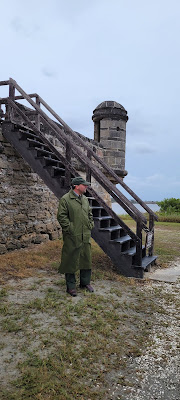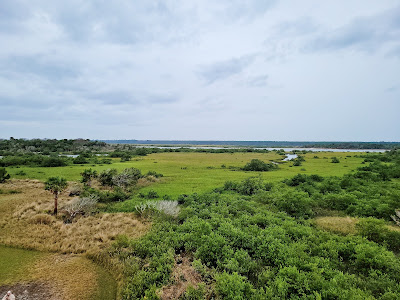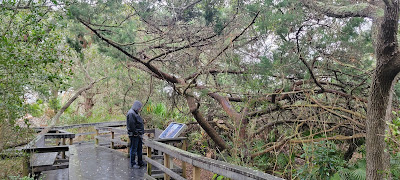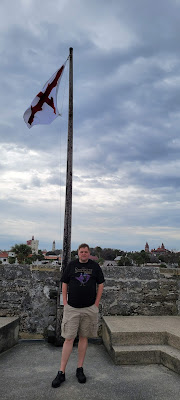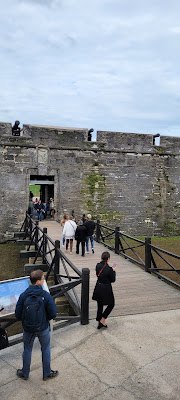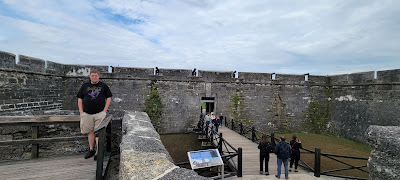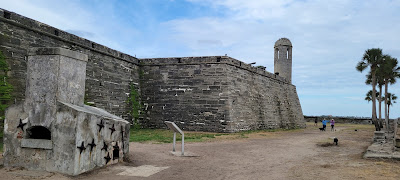Visited: Nov 2022
Nearby city: St. Augustine, FL
Last week's post was devoted to the large Spanish fort that protected the main harbor of St. Augustine, Castillo de San Marcos. Read about that visit here:
If you go to Castillo de San Marcos, make sure to also head about 15 miles south and check out the small, isolated outpost of Fort Matanzas.
Fort Matanzas lies along the Matanzas River. The Matanzas River is actually an estuary - a partially enclosed coastal body of brackish water (a mix of freshwater and saltwater). The Matanzas (Spanish word meaning "slaughters" or "killings") River is so named because it marks the spot where the Spanish Conquistador and founder of St. Augustine, Pedro Menendez de Aviles, executed 245 French Huguenots who had shipwrecked on their way to Fort Caroline (a short-lived unsuccessful French colony in Florida - near present-day Jacksonville). Menendez had been ordered by the Spanish crown to execute all Protestants he encountered in the New World.
Fort Matanzas was built along the Matanzas Inlet, the southern mouth of the Matanzas River. It was a strategic location to block any invasion of St. Augustine from the south. The Fort was built in 1742. It protected the "back-door" of St. Augustine.
Start your visit at the Visitor's Center and get a free ticket for the ferry out to the Fort (the ferry is your only option to tour the fort). You cannot reserve a ticket, you show up at the Visitor Center in person to get your ticket on a first-come first-served basis. The ferry shuttles visitors throughout the day, check the park website for times. NOTE *the ferry does not run on Mondays and Tuesdays*
It's a short ferry ride to the Fort, which sits on the small barrier island of Rattlesnake Island. We visited on a very rainy, overcast day. 😀
The Fort overlooks the Matanzas Inlet
approaching the Fort on the ferry
a rare, cold day in Florida
Like Castillo de San Marcos, Fort Matanzas is also built out of coquina, ancient seashells that have bonded to form a sedimentary rock similar to limestone. The Fort was small; a square-building 50-ft long on each side and a 30-ft high tower. The Spanish referred to the structure as Torre de Matanzas (Matanzas Tower). It was manned by one officer (who was in charge), four infantrymen, and two gunners. The soldiers served on rotation from their regular duty at Castillo de San Marcos in St. Augustine.
Five cannon were placed at the fort, four six-pounders and one eighteen-pounder. All five cannons could reach the inlet, which was only about a half-mile away.
Once your ferry docks, the Ranger will give you a guided tour of the Fort and tell you all about the lonely life of the soldiers stationed here and the rather harsh conditions.
Looking out towards the Matanzas Inlet and the Atlantic Ocean
Sleeping quarters
the flag of the Spanish Empire (the Cross of Burgundy) flies over the Fort
Shortly after the fort was completed in 1742, the English founder of the Colony of Georgia, James Oglethorpe, approached the Matanzas Inlet with 12 ships. Cannon fire from Fort Matanzas drove off Oglethorpe's scouting boats, and the warships departed without further incident. This ended up being the only "battle" that occurred at the Fort.
The Fort was briefly a part of the British Empire in the late 1700s due to the terms of the Treaty of Paris, but was then returned to the Spanish after the American Revolution. By that time, the power of the Spanish Empire had greatly dwindled, and the Fort was abandoned.
In 1916, the U.S. Department of War began a major restoration of the ruined fort, and Fort Matanzas became a National Monument in 1924.
Keep your eyes peeled for wildlife in and around the inlet. We spied a large heron.
We were lucky and got to see some dolphins
Back at the Visitor Center, take a quick walk along the Coastal Hammock Trail.
It was very neat to learn about the history of Spanish Florida at St. Augustine and the surrounding area.
For more info on Fort Matanzas:









